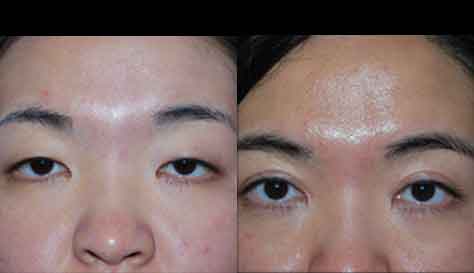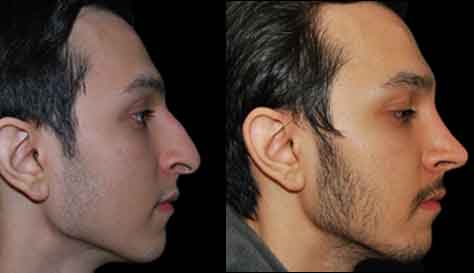Transgender Rhinoplasty
Conveniently located to serve the areas of New Jersey and New York
Dr. Ovchinsky is a nationally recognized expert in Rhinoplasty. For more information about this procedure please view our Rhinoplasty page.

Transgender rhinoplasty surgery involves surgical reshaping of a transgender patient’s nose to create either a more feminine or masculine appearance. This surgery is important when transitioning, as the nose is a focal point of the face. There are distinctive gender specific characteristics of the nose.
Female facial features can overall appear softer than male facial features. However, there isn’t a single feature that defines a “feminine” or “masculine” face. It is more so the result of a combination of multiple facial features, and the ratio of feminine to masculine features. Some facial features are traditionally considered to appear more masculine. These features include: strong brow bones, prominent noses and chins, thick eyebrows, a square jaw, a long face, and an Adam’s apple. Typically, a “masculine” look tends to involve chiseled and angular features. Contrastingly, women usually possess softer characteristics. This tends to look like a smooth forehead without bossing, a rounded chin, a dainty nose, fuller cheeks, and an arched brow.
For feminine rhinoplasties, female noses tend to be shorter, with narrower and well defined dorsum and uplifted smaller tips. Male noses, on the other hand, are usually larger, longer, with wider and higher nasal dorsum and wider, less uplifted nasal tips. Dr. Ovchinsky, who is a highly skilled surgeon, must strike a physical and aesthetic balance when reshaping the nose, especially in relation to other transition procedures that have or will be done. The ultimate goal is to enable the patient to present his or her gender with confidence.
The transgender patient who is making the physical transition from female to male (FTM) may opt to have rhinoplasty to augment the shape (and possibly the size) of the nose. In this rhinoplasty procedure, a larger and wider nose is created for a stronger, more masculine facial appearance. This is usually achieved by using cartilage or soft tissue grafts over the dorsum to increase both width and height. The nasal tip may be pushed down (or derotated) using various surgical techniques, and the width of the tip may be increased to give the nose a more masculine appearance.

The person transitioning from male to female (MTF) chooses rhinoplasty for exactly the opposite reason – to feminize the nose. FTM rhinoplasty redefines the nose by reducing the length and width of the nose, lowering the height of the dorsum, creating a better defined and more sculpted nasal tip and possibly adding a slight lift to the nasal tip. Either open or closed rhinoplasty approaches may be used in transgender rhinoplasty surgery.
How do you know if transgender rhinoplasty is right for you?
- You’ve put much thought and effort into transforming yourself externally to align with the gender you identify with internally.
- You have a positive outlook and realistic expectations.
- You are of the age to consent to the long lasting changes this surgery results in.
Rhinoplasty is an important step to feeling self-confident in your own skin when transitioning. Dr. Ovchinsky is able to help you decide on the best approach in your particular case during in person consultation. He will also go over surgical nuances in detail to make sure that all your questions are fully answered. To book your consultation, simply dial 973.379.0101 or fill out a contact form here.
FAQ
What do I need to avoid before surgery?
If you are on “blood thinners,” you will be asked to stop them approximately one week prior to surgery. We also ask that you avoid certain over-the-counter medications. If you are taking some herbal supplements, you should stop those as well as they may contain blood thinning substances. Also, you have to completely quit smoking at least two weeks before surgery.
What about my daily medications before surgery?
You will have a preoperative appointment well in advance of your surgery when we will review all mediations with you. If you are on “blood thinners,” you will be asked to stop them approximately one week prior to surgery. We also ask that you avoid certain over-the-counter medications. You may continue taking most routine medications up until the morning of surgery with a small sip of water.
What happens after surgery?
You will go to the recovery room for a few hours until you are fully recovered from anesthesia. Once you are stable you will be taken home (or to a hotel) by your family member or a friend. You will want to stay relaxed for the first few days. You will need to keep your head elevated when in bed to help with faster resolution of swelling. You should begin to start walking, eating, and using the restroom the day after surgery. Your activity can slowly increase each day but it will take up to 2 weeks before you start to feel like your old self again. You should avoid any strenuous activity for 4 weeks. You will need to take medication prescribed to you by Dr. Ovchinsky, which usually include antibiotics, pain medicine, antibiotic ointment for the incisions, and occasionally anti-nausea medications.
Are there any dietary restrictions following surgery?
No. Patients can eat whatever they want. Advance your diet from liquids (fruit juice, milk shake, etc.) to soft food (pudding, macaroni and cheese, mashed potatoes and gravy, oatmeal, pasta) to solids as tolerated. To prevent dehydration, please drink as much juices and nutritional fluid as possible.
When will my stitches be taken out?
Stitches are normally removed five to six days after your surgery.
How soon will I be able to exercise?
Dr. Ovchinsky recommends that patients do not return to exercise for three weeks after their procedure.
When will I be able to see the results?
You may see the difference right away, and more so once the swelling goes down within the first one to two weeks. As with any surgical procedure, it takes anywhere from 6 to 12 months for the results to become final.
What is special about the way Dr. Ovchinsky does the surgery?
Dr. Ovchinsky tailors his surgical technique to an individual patient rather than using the same “run of the mill” surgery on everybody. The technique he uses causes minimal pain, has natural results, and is long-lasting. The vast majority of patients are quite surprised afterward at how little discomfort they have and how quickly they return to normal activity. Most patients have minimal bruising. Finally, with Dr. Ovchinsky technique and attention to details during skin closure, scars are typically minimal and are often difficult to see once they have fully matured.





